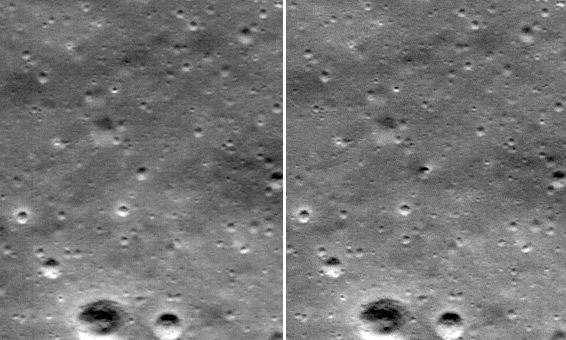Impact: Moon!
SLATE
Posted
Sunday, May 26, 2013, at 8:00 AM
A program designed to monitor the Moon detected a fairly large flash of light on the evening of Mar. 17. What they had seen was an actual impact of a small asteroid hitting the Moon’s surface!
The flash of light reached fourth magnitude, which means that if you
had been looking at the Moon at the time, you might have actually seen
the impact with your own eyes! Here are frames from the video sequence showing the impact:

On Mar. 17, 2013, a small rock hit the Moon at high speed, creating a bright flash of light.
Photo by NASA
Photo by NASA
You can also see them as an animation. NASA also put together a short video discussing what happened.
The object that hit the Moon was probably less than a half-meter in
size, not much bigger than a basketball, and had a mass of about 40
kilograms (90 pounds). But it was moving at high speed, something like
25 kilometers per second (15 miles per second), which is fast.
The energy of motion, called kinetic energy, is converted into light and
heat instantly when an object moving that rapidly hits something, which
is why impacts like that create an explosion. This one detonated like
the equivalent of several tons of TNT exploding.
It’s the brightest impact seen by the monitoring program in its eight
years of lunar observations. The Moon is probably hit all the time, but
most are too faint to catch, or happen on the far side where we can’t
see them, or happen where the Moon is lit by the Sun and are drowned out
by the bright landscape. That means, statistically speaking, for every
one impact seen, many more must be happening. More than 300 impacts have
been seen by the program.

A telescope caught the asteroid impact getting bright enough to see
with the naked eye. Note the darkened edge of the Moon at the top.
Photo by NASA
Photo by NASA
Even more interesting, this flash happened around the same time
meteor monitoring stations on Earth reported a flurry of meteors burning
up in Earth’s atmosphere, and it’s possible these events were
connected; a stream of debris may have been passing by and impacted both
us and the Moon (and let me note that it’s not like we’re suddenly being attacked from space;
we’re just getting better at observing them). This type of information
is important to understand since our presence in space is growing; if we
put bases on the Moon it’ll be very useful indeed to know how often the
Moon is hit, and how large the impactors are!
I’ll note that new craters have also been seen by the Lunar
Reconnaissance Orbiter, which has been orbiting the Moon since 2009.
It’s detected some that are new at least since the 1970s, because they weren’t seen in Apollo photos.
In fact, several craters have been identified that didn’t exist even in
earlier LRO images, meaning they are less than four years old! Here’s one, seen before (left) and after (right):

Before (left) and after (right) showing a new crater on the Moon, centered in both frames.
Photo by NASA/GSFC/Arizona State University
Photo by NASA/GSFC/Arizona State University
The new crater is centered in both images, it happened on top of an
older crater. You can see the spray of brighter, fresher material in the
“after” image (there’s also an animated GIF that toggles between the two images).
I’m pleased to see these programs successfully capturing new
cratering events! Objects this small are almost impossible to observe
before they hit the Earth, so having good evidence of lunar impacts
gives us a better understanding of the size range of objects in space. As Chelyabinsk showed us, even smallish objects can be pretty, um, dramatic, so we really need to have a firmer grip on what’s out there.


0 Comments:
Post a Comment
<< Home